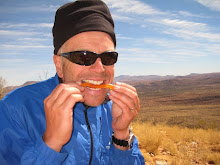Pumping up road bike tyres is more challenging to the nerves than to precision; you attach a track pump and keep going. 100psi, 120, 125. How much safety margin did the manufacturer leave between their recommended maximum pressure and the point of explosion? In contrast I usually inflate mountain bike tyres to below the manufacturers minimum limit. The difference between 25 and 30 psi can be hard to see on a small gauge. A squeeze of the tyre is subjective, not objective.
I went for Schrader values on the Simpson Desert Challenge because you can get cheap, accurate pressure gauges. You can't control what you can't measure and I wanted to know what different pressures would feel like. What was the minimum pressure I could use before the tubeless setup failed? Once I had completed my ghetto tubeless conversion I tested it on the beach and made a note of the pressures that worked. I also tested it on my long 100km cycle; there are plenty of boulders on the descent from Andersons to Bedford Creek and if the setup would handle these I figured that it would stay together on the Simpson.
Tyres on fat rims have a very different feel to same tyres on narrow rims. For example, 25 psi might feel soft on narrow rims but feels as hard as nails on a fat rim. I think the answer lies in the profile. Fat rims give the tyre a much flatter profile which has to defect less in order to present the same surface area to the ground. Soft, fat tyres roll over small stones that would normally have you bouncing around.
It took a couple of goes to find some good sand. The ocean beaches around Sydney are too soft - the waves constantly lift and re-lay the sand. The sand on the harbour beaches is more settled. In the end I used Clontarf for my testing, in the early morning to avoid cycling over sunbathers. I started from 25 psi and worked down from there, repeating the same loop across the beach and back through the kiddies playground, loosing a couple of psi, then riding again.
What I found was this.
If you can't steer (the front wheel ploughs and bucks you off) you need to loose some air from the front tyre.
If you have too much drag you need to loose some air from the back tyre.
Small changes in pressure have big effects (15 psi is very different from 18 psi)
There are other considerations. Testing on the sand leads you to lower and lower pressures. When you cycle on the road again these soft tyres feel SLOW :- there is a compromise there. Tyres with thin sidewalls tend to crease when they get too soft - you have to worry about their longevity and wether they will delaminate during the race.
In the end, with 2.4 inch tyres holding up 95kg's of primate I settled on starting pressures of 15 rear, 12 front. I knew that 12 and 10 would go a little better on the sand, and that 10 and 8 would still hold together. I never got low enough to check the burping pressure of my ghetto setup.
As a final check I rode the Double Double @ 15 and 12. It was my fastest ever trip and proved to me that the rolling resistance was not a real handicap off-road.
When you think about it, the SDCC is basically flat. On a hard, flat surface anyone can cycle @ 12km per hour - you can even run at that pace. The real problem is the sand dunes that lie across the track. A bike that rides well on the sand is a great help.
New Radio Show!
5 years ago
